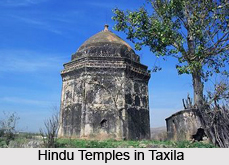 Taxila is located in the Punjab Province of Pakistan, about 30 kilometers from Islamabad. Taxila was an important center of learning during the 5th century BCE. Taxila was also an important cultural center and it is said that Mahabharata was first recited at Taxila. Present day Taxila is one of the six sub-district of Rawalpindi District. It is spread over in the periphery of Pothohar Plateau of the Punjab.
Taxila is located in the Punjab Province of Pakistan, about 30 kilometers from Islamabad. Taxila was an important center of learning during the 5th century BCE. Taxila was also an important cultural center and it is said that Mahabharata was first recited at Taxila. Present day Taxila is one of the six sub-district of Rawalpindi District. It is spread over in the periphery of Pothohar Plateau of the Punjab.
History of Taxila
According to legends the ancient Indian king Taksha founded the city of Takshashila. The word Takshashila (in Sanskrit) means belonging to King Taksha. Taksha was the son of Bharata and Mandavi, who are the historical characters in Ramayana. The etymology of Taxila can be traced to a to a tribe called the Takka.
According to legends, Taxila was founded in the seventh or sixth century BCE by one of the sons of Rama, the hero of Ramayana. The first town of Taxila was built on a hill. The cite of Taxila where Mahabharata was first recited is known as Bhir mound.
Taxila was the capital of the kingdom that was called as Hinduš (or Indus-country). Later it was added to the Achaemenid Empire under king Darius I the Great. But the Persians could not dominate Taxila for long. It is said that in 329 BCE, King Ambhi of Taxila invited Alexander because he needed support against king Porus of Pauravas, which was a state in the eastern Punjab. Alexander defeated Porus on the banks of Jhelum but unexpectedly allied himself with Porus. Alexander died on 11 June 323, in far-away Babylon and the city of Taxila was succeeded by Chandragupta. Later Bindusara succeeded Chandragupta. After which, his son Ashoka succeeded him. Ashoka was famous for his religious policy. It was he who stimulated Buddhism. The Dharmarajika monastery, where Ashoka buried several relics of Buddha, is still famous for its stupa. In 184, the Greeks invaded Gandara and then on there was a Greek king (Demetrius) in Taxila. He rebuilt the town of Taxila on the plains on the other bank. The new Taxila was built according to the Greek fashion. The kingdom of Demetrius consisted of Gandara, Arachosia, the Punjab and a part of the valley of Ganges.
 Later the Sacastane or Sistan`s launched raids on Gandara and infiltrated in the southern Indus valley and they took over Taxila. In ca. 80 CE, the Yuezhi nomads or Kushans took over the area. Again the city of Taxila was refounded. Buddhist pilgrims visited from then on Taxila from countries as far as from Central Asia and China.
Later the Sacastane or Sistan`s launched raids on Gandara and infiltrated in the southern Indus valley and they took over Taxila. In ca. 80 CE, the Yuezhi nomads or Kushans took over the area. Again the city of Taxila was refounded. Buddhist pilgrims visited from then on Taxila from countries as far as from Central Asia and China.
The Parthians became interested in the region and during the first quarter of the first century annexed the Greek kingdoms of Gandara and Punjab. The final period is called the Gandhara period. The great Kushan Dynasty was then established in 50 A.D, and within these 200 years Taxila became the most renowned center for philosophy, art and learning
The city of Taxila was badly damaged when the Huns invaded the Punjab in the fifth century, and never recovered. Before the fall of the invader kings, Taxila was a regional and national capital for many dynasties, and a true center of learning for Vedic learning.
Important Places of interest in Taxila
Taxila is an important archeological center, which is worth to be visited. At Taxila you can see the statue of great Buddha. Other statues of Taxila are, Alexander of Macedonia, Asoka the famous Buddhist king and Kanishka. The place echoes with voices from the past. A large number of tourists from China and Greece visit Taxila.



















